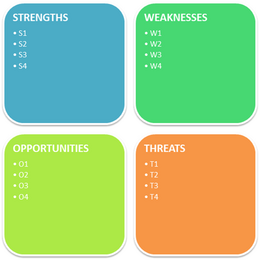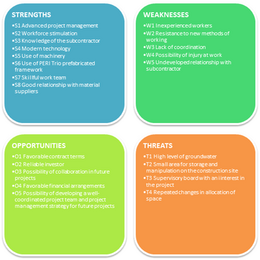SWOT Analysis in Construction Projects
(→The SWOT Matrix) |
(→Investor's Perspective) |
||
| Line 51: | Line 51: | ||
When evaluating a project, investment decisions depend on the decision maker’s attitude toward the risk. As a rule, most investors accept a project that is likely to succeed because they have a natural aversion toward risk. However, there is always an element of risk about the project outcome, and the decision maker has to determine how much risk he is willing to take. When he sets priorities among the project goals, the investor has to consider carefully the risks he can be exposed to during construction, and he has to predict all the consequences of those risks. If the investor is not qualified to consider the potential risks, he can hire specialized consultants to help with the risk assessment and develop a plan to minimize any risk. | When evaluating a project, investment decisions depend on the decision maker’s attitude toward the risk. As a rule, most investors accept a project that is likely to succeed because they have a natural aversion toward risk. However, there is always an element of risk about the project outcome, and the decision maker has to determine how much risk he is willing to take. When he sets priorities among the project goals, the investor has to consider carefully the risks he can be exposed to during construction, and he has to predict all the consequences of those risks. If the investor is not qualified to consider the potential risks, he can hire specialized consultants to help with the risk assessment and develop a plan to minimize any risk. | ||
| + | |||
| + | [[File:swot investor.pgn]] | ||
==== Contractor's Perspective ==== | ==== Contractor's Perspective ==== | ||
Revision as of 19:24, 6 March 2022
Developed by Maria Kylafi
SWOT analysis is a significant tool for strategic planning, especially useful in the stage of identifying strategies, in order to eliminate uncertainty and risks. It shall apply for situational analysis, through which it can adapt its internal structure, activities and processes to the economic environment in the selection and project management process. [1] The main factors that are taken into consideration when implementing a SWOT analysis are the internal components (strengths and weaknesses), as well as the external components (opportunities and threats). The matrix that is created can be used within an organization or for the implementation of a project as a way to identify the strategic holes related with it, during the phases of planning, contracting and construction of the project. The example that is going to be used in order to portray the application of SWOT analysis is the case of Azzaro project in Serbia, both by the investor’s and the contractor’s perspective.
The following article aims to present the SWOT analysis method and framework, as part of risk management process and apply the theory into a real construction project, with emphasis in the different stakeholders’ perspective and approach of the project. Furthermore, the author’s reflections regarding the advantages and the limitations of this tool will be presented in order to highlight its crucial value in project management.
Contents |
Introduction in SWOT Analysis
The Use in Project, Program and Portfolio Management
The method of SWOT Analysis was initially intending to help organizations take into consideration and realize the factors associated with decision making. This method was presented in the 1960s by Albert Humphrey of the Stanford Research Institute, while conducting a study related to the identification of the root cause of consistent failure in corporate planning. Since the time it was introduced, SWOT has become one of the most useful tools for business owners and managers in order to have a clear view of the companies. [2]
In general, effective project management requires a development of a mission statement for the project, i.e. what is to be implemented, the goals and the desired outcome. [3] It is necessary to clarify in advance as well as during all steps of project implementation all the elements that have an impact on its effectiveness. Moreover, it is important that these elements such as time limitations, prearranged costs, quality standards are identifies, so that the issues arising are being addressed immediately by the project managers or the contractors.
SWOT Analysis examines the business organization and its project from the point of view of the external and internal environment. According to Rainer Züst and Peter Troxler, SWOT Analysis Matrix gives the opportunity to evaluate the results and evaluations that are associated with from both the present and the future-related views. In a SWOT Analysis the strengths and weaknesses as well as the opportunities and threats are listed in a matrix vertically and horizontally, respectively. Strengths and weaknesses and opportunities and threats that have the same cause, could require mostly likely similar or the same actions.
As described in ISO 21500:2021, the organizational environment is affected both by internal and external factors influencing organizational activities and decision-making. An organization should consider influences internal influences regarding the governance and management of projects, programs and portfolios. The internal environment includes internal stakeholders is affected by the structure, processes and culture of the organization and could consist of sponsors, members of the governing body, managers in functional roles, employees, project managers. The external environment of the organization affects the organization’s ability to realize benefits and could include factors related to opportunities and threats arising from economic, political, social, legal and environmental constraints, as well as expectations and requirements by external stakeholders. In a SWOT Analysis, the strengths and weaknesses are connected with the internal environment, while the opportunities and threats are connected with the external. [1]
SWOT Analysis Components
- Strengths: All qualities, assets and other positive facts that are considered to be useful for the fulfillment of the goal and have a beneficial effect or provide a competitive edge. (4) Strength at organizational level involves properties and abilities by which an organization gains an advantage over other organizations and competitor organizations that are revealed as a result of the analysis of its internal environment. In other words, organizational strength defines the characteristics and situations in which an organization is more effective and efficient compared to their competitors. (5)
- Weaknesses: Facilities, financial resources, management capabilities, marketing skills, and brand image can be sources of weaknesses. (6) Weakness at organizational level refers to the situations in which the current existence and ability capacities of an organization are weaker compared to other organizations and competitor organizations. In other words, organization weakness means the aspects or activities in which an organization is less effective and efficient compared to its competitors. These aspects negatively affect the organizational performance and weakens the organization among its competitors. Consequently, the organization is not able to respond to a possible problem or opportunity, and cannot adapt to changes. (5)
- Opportunities: All current and also future positive changes, which follow or may result from the external environment (the one beyond realization) of the evaluated area. Namely, all the real and potential facts and conditions, which are of advantage for the evaluated area or might be helpful in fulfilling the basic goal. (4) They are the conditions in the external environment that allow an organization to take advantage of organizational strengths, overcome organizational weaknesses or neutralize environmental threats. (7)
- Threats: All environmental factors that can impede organizational efficiency and effectiveness are threats. (5) Threats are the situations that come out as a result of the changes in the distant or the immediate environment that would prevent the organization from maintaining its existence or lose its superiority in competition, and that are not favourable for the organization. (8)
The SWOT Matrix
tbd
tbd
tbd
Application in Construction Projects
SWOT Analysis in Azzaro construction project
During the planning, contracting and implementation of a construction project, it is crucial to identify the parameters and risks that could possibly lead to not desired consequences. In that case, SWOT Analysis is considered to be a useful method to recognize and eliminate uncertainty. For a construction project it would be helpful to understand the risks for the main stakeholders (investors and contractors), which would also clarify the conflicting interests and different goals. Thus, it offers the opportunity for efficient risk prediction and management, starting from the planning phase.
As an example, SWOT Analysis in Azzaro construction project based on the paper "Practical Appliction of SWOT Analysis in the Management of a Construction Project" will be presented below. All components were analyzed both by contractor's and investor's perspective.
Investor's Perspective
When evaluating a project, investment decisions depend on the decision maker’s attitude toward the risk. As a rule, most investors accept a project that is likely to succeed because they have a natural aversion toward risk. However, there is always an element of risk about the project outcome, and the decision maker has to determine how much risk he is willing to take. When he sets priorities among the project goals, the investor has to consider carefully the risks he can be exposed to during construction, and he has to predict all the consequences of those risks. If the investor is not qualified to consider the potential risks, he can hire specialized consultants to help with the risk assessment and develop a plan to minimize any risk.
Contractor's Perspective
From the contractor's perspective, SWOT is suitable for the planning and contracting phases. Sometimes, an experienced contractor can, before signing the contract, influence its form and content, especially if he has properly investigated the market and has done a large number of favors for the investor during the concept phase of the project. Taking into account that the one who finances the project is the one who decides, the investor still has the greatest influence on the text of the contract, and potential investors need to become familiar with contracts as much as possible.
Discussion
Advantages
Limitations
Annotated Bibliography
Rainer Zuest and Peter Troxler: No More Muddling Through (2006), Springer, pp. 35-39
ISO 21500:2021
References
- ↑ 1.0 1.1 Galabova, B. (2018), Application of the SWOT-analysis in Project Management in Business Organizations. Science & Research, 2(1), 21–26.
- ↑ Schooley, S. (2021, December 1). SWOT Analysis: What It Is and When to Use It. Business News Daily. [1]
- ↑ Sabbaghi, A., & Vaidyanathan, G. (2004). SWOT analysis and theory of constraint in information technology projects. Information Systems Education Journal, 2(23), 3–19. Retrieved from [2]

